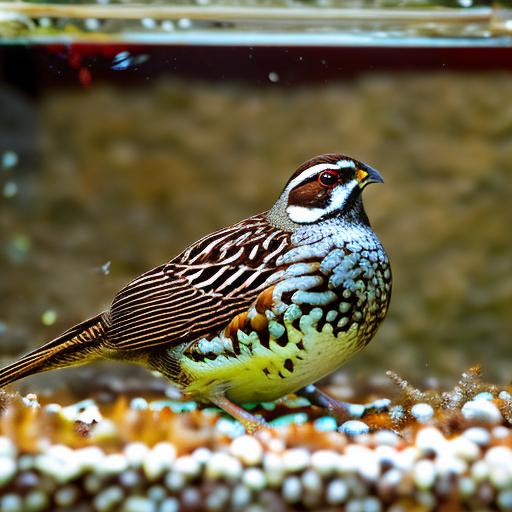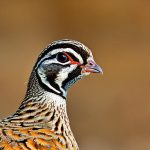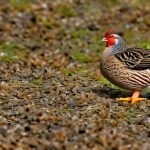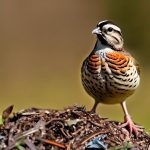Keeping quail in a fish tank is a unique and innovative way to raise these small game birds. Quail are known for their small size, gentle nature, and delicious eggs, making them a popular choice for backyard poultry enthusiasts. While traditional methods of raising quail involve outdoor coops and pens, using a fish tank offers a compact and convenient alternative for those with limited space or who live in urban areas. By providing the right environment, food, and care, quail can thrive in a fish tank setting, making it an attractive option for those looking to raise these charming birds.
Quail are social animals that thrive in small flocks, making them well-suited for life in a fish tank. Their small size and gentle nature make them an ideal choice for indoor bird keeping, and their ability to lay eggs makes them a practical addition to any household. By understanding the specific needs of quail and providing a suitable environment, it is possible to successfully raise these birds in a fish tank. In this article, we will explore the various aspects of keeping quail in a fish tank, including choosing the right tank, setting it up, feeding and watering the quail, maintaining their health and hygiene, and providing enrichment and space for them to thrive. With the right knowledge and care, keeping quail in a fish tank can be a rewarding and enjoyable experience for bird enthusiasts of all levels.
Key Takeaways
- Keeping quail in a fish tank is a unique and space-saving way to raise these birds
- Choosing the right tank size and type is crucial for the well-being of quail
- Setting up the tank with proper bedding, nesting areas, and perches is essential for quail comfort
- Feeding and watering quail in a fish tank requires special consideration and care
- Regular maintenance and hygiene practices are necessary to keep quail healthy in a fish tank
Choosing the Right Tank for Quail
When it comes to choosing the right tank for quail, there are several factors to consider to ensure the birds’ comfort and well-being. The size of the tank is crucial, as quail require ample space to move around, stretch their wings, and engage in natural behaviors. A general rule of thumb is to provide at least 1 square foot of space per quail to allow for adequate movement and social interaction. Additionally, the tank should be tall enough to accommodate the quail’s natural inclination to perch and roost.
In terms of material, glass tanks are often preferred over acrylic or plastic tanks, as they provide better insulation and are less prone to scratching. The tank should also have a secure lid to prevent the quail from escaping and to protect them from potential predators or household pets. It is important to consider the ease of cleaning and maintenance when selecting a tank, as keeping the environment clean is essential for the health and hygiene of the quail. Finally, it is advisable to choose a tank with good ventilation to ensure proper air circulation and prevent the buildup of ammonia from the birds’ waste. By carefully considering these factors, it is possible to select a suitable tank that meets the needs of quail and provides a comfortable and safe living space for them.
Setting Up the Tank for Quail
Setting up the tank for quail involves creating a suitable environment that mimics their natural habitat while also providing for their specific needs in captivity. The tank should be lined with a suitable substrate, such as wood shavings or straw, to provide a comfortable surface for the quail to walk on and to absorb waste. It is important to avoid using materials that are toxic or dusty, as these can be harmful to the birds’ respiratory system. Additionally, providing hiding spots and areas for dust bathing can help satisfy the quail’s natural instincts and reduce stress.
The tank should be equipped with appropriate perches or roosts to allow the quail to rest and perch at different heights. Natural branches or commercially available perches can be used to provide variety and stimulation for the birds. Access to fresh water is essential, and it is advisable to use a shallow dish or waterer that is easy for the quail to access without the risk of drowning. Additionally, providing a balanced diet of commercial quail feed supplemented with fresh greens, fruits, and vegetables will help ensure the birds receive essential nutrients for their health and well-being. By carefully setting up the tank with these considerations in mind, it is possible to create a comfortable and enriching environment for quail to thrive in captivity.
Feeding and Watering Quail in a Fish Tank
Feeding and watering quail in a fish tank requires careful attention to ensure the birds receive a balanced diet and access to clean water at all times. Quail are omnivorous birds that require a diet rich in protein, vitamins, and minerals to support their growth, egg production, and overall health. Commercial quail feed is readily available and formulated to meet the specific nutritional needs of these birds. It is important to provide access to feed at all times, either by using a feeder or by scattering the feed on the substrate to encourage natural foraging behavior.
In addition to commercial feed, quail can benefit from supplemental foods such as fresh greens, fruits, vegetables, and small insects or mealworms. These foods provide variety and essential nutrients that may be lacking in commercial feed alone. It is important to monitor the quail’s food intake and adjust their diet as needed based on their activity level, age, and overall health. Access to clean water is essential for quail, as they can quickly become dehydrated without an adequate water supply. Using a shallow dish or waterer that is easy for the birds to access will help ensure they stay hydrated without the risk of drowning. Regularly cleaning and refilling the water container will help maintain good hygiene and prevent the spread of disease. By providing a balanced diet and access to clean water, it is possible to support the health and well-being of quail in a fish tank setting.
Maintaining the Health and Hygiene of Quail in a Fish Tank
Maintaining the health and hygiene of quail in a fish tank is essential for preventing disease and ensuring the birds thrive in captivity. Regular cleaning of the tank is crucial to remove waste, uneaten food, and soiled bedding that can harbor bacteria and parasites. The substrate should be replaced regularly, and any soiled areas should be spot-cleaned as needed to maintain a clean and comfortable living environment for the quail.
In addition to cleaning the tank, monitoring the quail for signs of illness or injury is important for early detection and treatment. Common health issues in quail include respiratory infections, parasites, and injuries from pecking or fighting. Providing regular health checks and observing the birds’ behavior can help identify any potential problems early on. It is advisable to consult with a veterinarian experienced in avian care if any health concerns arise.
Quarantining new birds before introducing them to an existing flock can help prevent the spread of disease. Additionally, practicing good biosecurity measures such as washing hands before and after handling the birds, disinfecting equipment, and limiting exposure to wild birds can help reduce the risk of disease transmission. By maintaining good hygiene practices and monitoring the health of the quail, it is possible to create a healthy and safe environment for these birds in a fish tank setting.
Providing Enrichment and Space for Quail in a Fish Tank

Providing enrichment and space for quail in a fish tank is essential for supporting their physical and mental well-being. Quail are active birds that enjoy exploring their environment, scratching at the ground, dust bathing, perching, and engaging in social interactions with other birds. Providing ample space within the tank allows the quail to move around freely, stretch their wings, and engage in natural behaviors.
In addition to space, providing enrichment activities such as hanging toys, mirrors, or natural branches can help stimulate the quail’s curiosity and provide mental stimulation. Dust bathing areas can be created by providing a shallow dish filled with sand or dusting powder that allows the birds to clean their feathers and skin naturally. Offering hiding spots or shelters within the tank can provide security for the birds and reduce stress.
Social interaction is important for quail, so keeping them in small flocks allows them to engage in natural behaviors such as grooming each other, establishing pecking orders, and communicating through vocalizations. Providing opportunities for socialization within the tank can help reduce stress and promote overall well-being for the birds. By providing enrichment activities and ample space within the tank, it is possible to create a stimulating environment that supports the natural behaviors of quail in captivity.
Conclusion and Considerations for Keeping Quail in a Fish Tank
In conclusion, keeping quail in a fish tank offers a unique and practical way to raise these charming birds in an indoor setting. By choosing the right tank, setting it up with suitable substrate, perches, food, and water sources, maintaining good hygiene practices, and providing enrichment activities and space for the birds, it is possible to create a comfortable and stimulating environment for quail in captivity.
When considering keeping quail in a fish tank, it is important to research local regulations regarding bird keeping and ensure that adequate space, ventilation, and environmental enrichment are provided for the birds’ well-being. Additionally, seeking advice from experienced quail keepers or avian veterinarians can provide valuable insights into meeting the specific needs of these birds in captivity.
Overall, keeping quail in a fish tank can be a rewarding experience that allows bird enthusiasts to enjoy the charm of these small game birds while also benefiting from their delicious eggs. With proper care and attention to their needs, quail can thrive in a fish tank setting and provide enjoyment for their keepers for years to come.
If you’re interested in keeping quail in a fish tank, you might also want to explore the benefits of raising chickens in a coop. Poultry Wizard’s article on chicken coop design in Grand Island, NE provides valuable insights into creating a comfortable and safe environment for your feathered friends. Just like quail, chickens require proper housing and care to thrive, making this article a great resource for poultry enthusiasts.
FAQs
What are the benefits of keeping quail in a fish tank?
Quail are relatively low maintenance and can be kept in a small space, making them suitable for a fish tank. They also provide entertainment and can be a source of fresh eggs.
What size fish tank is suitable for keeping quail?
A 20-gallon fish tank is recommended for keeping quail. This provides enough space for the quail to move around and for their food and water dishes.
What do quail eat and drink?
Quail eat a diet of commercial quail feed, supplemented with fresh greens and occasional treats like mealworms. They also need access to clean water at all times.
How do you maintain the cleanliness of the fish tank when keeping quail?
Regular cleaning and maintenance of the fish tank is essential when keeping quail. This includes removing droppings, changing the bedding, and cleaning the food and water dishes regularly.
Can quail be kept with other fish or animals in the fish tank?
It is not recommended to keep quail with other fish or animals in the fish tank. Quail may become stressed or aggressive in the presence of other animals, and their living conditions may not be suitable for other species.
What are the potential challenges of keeping quail in a fish tank?
Some potential challenges of keeping quail in a fish tank include maintaining proper ventilation, providing adequate space and enrichment for the quail, and ensuring that the tank is secure to prevent escapes. Additionally, quail can be noisy, so consideration should be given to their placement in the home.
Meet Walter, the feathered-friend fanatic of Florida! Nestled in the sunshine state, Walter struts through life with his feathered companions, clucking his way to happiness. With a coop that’s fancier than a five-star hotel, he’s the Don Juan of the chicken world. When he’s not teaching his hens to do the cha-cha, you’ll find him in a heated debate with his prized rooster, Sir Clucks-a-Lot. Walter’s poultry passion is no yolk; he’s the sunny-side-up guy you never knew you needed in your flock of friends!







